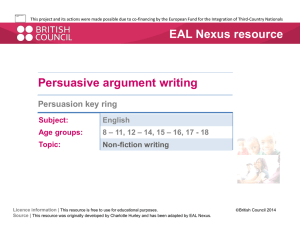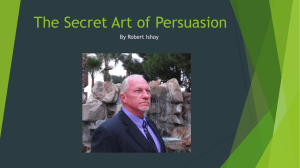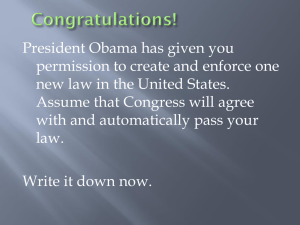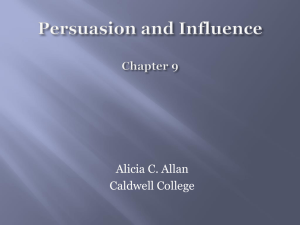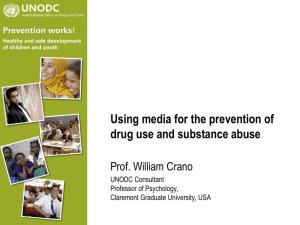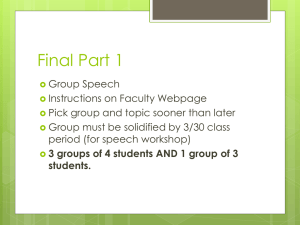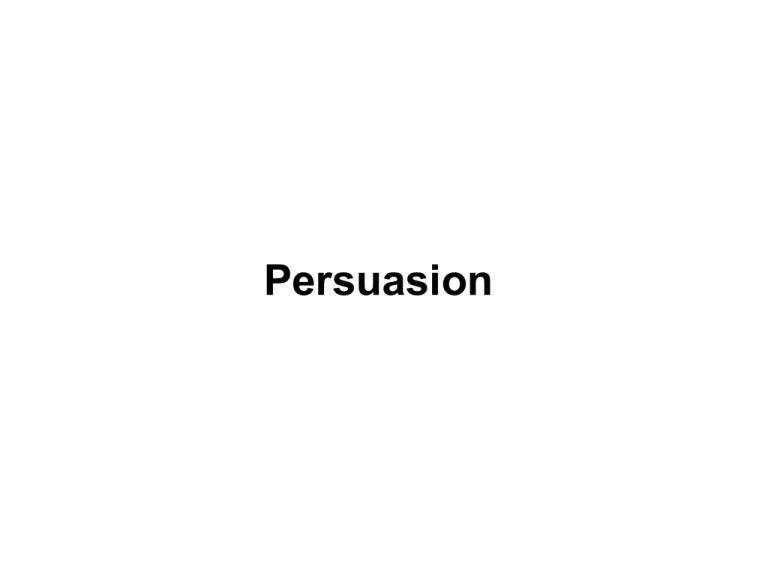
Persuasion
What is persuasion?
Persuasion: the process by which a message induces change
in beliefs, attitudes, or behaviors.
I. Where does persuasion live? Everywhere!
A. The Media
B. Science
C. The Arts
D. Interpersonal Encounters (where persuasion attempts
are most prevalent and have their greatest impact)
II. The Pathways of Persuasion
A. The Central Route to Persuasion: the case whereby
people “systematically process” a persuasive communication,
listening carefully to and thinking about the arguments. This
occurs when people have both the ability and the motivation
to listen carefully to a communication.
B. The Peripheral Route to Persuasion: the case whereby
people “heuristically process” a persuasive communication and
are swayed by peripheral cues (such as a speaker’s
appearance or the amount of evidence rather than the quality
of evidence). This occurs when people do not have the ability
and/or the motivation to listen carefully to a communication.
C. If it’s a complex message, written communication is
more effective in changing attitudes.
D. If it’s a simple message, audio-visual is more effective in
changing attitudes.
III. The Communicator: Who is the
Messenger?
I. Credibility: judgments made by a perceiver
concerning the believability of a communicator.
A. Credibility is dynamic. It can change over time, and
even during a single persuasive message.
B. The Sleeper Effect: refers to a situation in which a message
attributed to a lower credibility source becomes more
persuasive over time compared to a message attributed to a
high credibility source.
1) The sleeper effect operates through a process of
disassociation, whereby a message becomes
separated from its source in the minds of receivers.
2) Although the sleeper effect has been empirically
documented in laboratory settings, it is difficult to
produce in real-world settings.
C. The underlying dimensions of credibility.
1) Expertise (competence, qualification)…
Expertise can be established by possessing advanced degrees
(Ph.D.) or through experience like a recovered alcoholic serving
as a coordinator at AA meetings. Both of these help to give the
impression that you are knowledgeable.
Mature angular faced people appear more like experts than
baby faced people.
Taller people appear more like experts than shorter people and
people with a full head of hair appear more like experts than
bald people.
2) Trustworthiness…
Looking someone straight in the eye…
Although eye contact may make a person more persuasive by
increasing perceptions of trustworthiness, its effectiveness
may depend on a number of factors (e.g., the legitimacy of the
request that’s made).
Baby faced people appear more trustworthy than mature angular
faced people.
Arguing against your own self-interest.
Fast talkers appear more credible and trustworthy than
slow-talkers.
3) Goodwill: perceived caring.
4) Composure: speaking confidently and being
straightforward.
II. Liking: favorable judgments made by a perceiver
concerning the believability of a communicator.
A. Charisma: someone who possesses a certain indefinable
charm or allure.
B. Celebrities…
1) Advertisers frequently rely on celebrity endorsers to
boost their company’s image because consumers like,
or may even idolize, those celebrities.
2) If a celebrity endorser becomes embroiled in a
scandal, the sponsor’s image may suffer as well.
C. Attractiveness…
1) We perceive attractive people to be healthier, happier,
more sensitive, more successful, more intelligent, and
more socially skilled.
2) Attractive well-dressed people are more likely to make
a favorable impression on potential employers and get
out of legal trouble.
3) People are more likely to vote for attractive candidates.
D. Similarity…
1) We are more likely to help and like others who are
dressed similarly to us.
2) We are more likely to help and like others who have
similar backgrounds and interests.
3) People are more likely to buy products, sign petitions,
and agree to other activities when the seller is perceived
as similar in age, religion, politics, etc.
4) Similar Names!
5) Kidney Donors!
E. Mimicry Fosters Liking
F. Compliments…
1) Compliments can significantly increase someone’s
liking of you EVEN when they know you have ulterior
motives.
2) Ingratiation: the act of gaining acceptance or affection
for yourself by persuasive and oftentimes subtle compliments.
3) However, transparent attempts at ingratiation are less
effective than well-disguised, or genuine efforts at
ingratiation.
IV. The Communication: What is the
message and how is it being delivered?
Fixed-Action Patterns: mechanical like behavior sequences.
Trigger Feature: a specific cue that activates the fixed-action
pattern.
I. Visual Persuasion
A. Iconicity: images can represent, or sum up, ideas and
concepts. They serve as symbolic representations of things.
1) Iconic images evoke emotional responses in receivers.
2) Iconic images can distort or violate reality.
3) Iconic images are selective; they can exaggerate or
minimize certain features over others.
Fast Food! It looks delicious, right???
B. The Persuasiveness of Architecture
1) Architectural design can facilitate certain forms of
behavior and inhibit others.
2) Visual and spatial cues affect people’s perceptions
of, and attitudes toward, their environment.
C. The Persuasiveness of Color
D. The Persuasiveness of Art
1) Historically, art has been used to further political,
religious, and social ends.
2) The arts have been used as tools for political and
societal propaganda, most notably by totalitarian
regimes.
3) Artists use their art to make political and social
statements.
E. The Persuasiveness of Movies
1) Storytelling in movies as persuasion.
2) Viewers do not expect to be persuaded by movies, so
they let down their guard.
3) Movies promote popular culture (fashions, trends,
lifestyles).
4) Movies promote viewer identification with the
characters.
F. The Persuasiveness of Television
1) The Selection of Issues
Sensationalism: when more exciting (often visually
exciting) stories are chosen over less exciting stories
even if the less exciting stories are more newsworthy.
2) The Selection of Guest and Panel Members
3) What is Included on a Set
4) Camera Angles and Cuts
II. Music and Persuasion
A. Song lyrics can persuade via the central route, but may
be more effective than words alone because the music
helps to relax the listener and be more open to the message.
B. Typically, however, music persuades via the peripheral
route because it puts people in a better mood and relaxes
them while there exposed to advertisements.
C. Background music is used by retailers to influence
consumer behavior.
1) Background music has been shown to affect shopping pace.
2) Background music has been shown to affect moods.
D. The Right Ear!
III. Aromas and Persuasion
A. Fragrance manufacturing is a multi-billion dollar
industry. However, much of what sells a fragrance, like a
perfume, is the promise that you will be sexy like the
model in the ad supposedly using the perfume.
B. Some evidence suggests that fragrances may increase
attraction.
C. As with positively received music, ambient aromas (like
vanilla, chocolate, and floral scents) can affect consumers’
shopping pace, and make them linger longer in stores and
restaurants.
D. Repeated exposure to a given fragrance may result in
desensitization, or create an aversion to the smell.
IV. Haptics: the study of touch. Touching other people,
if done appropriately, tends to facilitate persuasion.
V. Proxemics: the study of how we use space to
communicate.
A. Invading another person’s space facilitates persuasion
if the invader is perceived as rewarding but hinders
persuasion if the invader is not perceived as rewarding.
B. The degree of personal space distance between two
people varies across cultures.
VI. The Scarcity Principle: opportunities seem more
valuable to us when they are less available.
A. Limited Numbers: when we learn that there are only a few
left in stock or that it’s the last one in stock, we have a tendency
to assume that it is of remarkable value. It is kind of like the
social proof of material goods. If everyone is buying it, it must
be the thing to have.
B. Time Limits: when we believe that we must act now in
order to get the deal or the product or the deal or the product
will be gone, we are enticed to do so.
1) Chronemics: the study of how time is used to
communicate.
C. Psychological Reactance: whenever free choice is limited
or threatened, the need to retain our freedoms makes us want
free choice significantly more than before. Therefore, when
increasing scarcity interferes with our prior access to some
item, we will react against the interference by wanting and
trying to possess the item more than we did before.
D. Censorship: when information becomes censored, it
becomes scarce. This increases the appeal of acquiring such
information.
E. Optimal Conditions
1) New Scarcity is More Powerful than Constant Scarcity
2) Competition for Scarce Resources: social demand
increases liking of products.
VII. Subtle Persuasion
A. Subliminal Messages: are processed without conscious
awareness.
1) Claims that subliminal stimuli in advertisements
can make people buy things are unsupported.
B. Supraliminal Messages: are subtle, or faint, but are still
processed consciously.
C. Logos
D. Slogans or Catch Phrases
E. Cute Animals
VIII. Sex Appeals
A. Sex appeals function as peripheral cues to persuasion,
and operate through the process of association.
B. The implicit associations advertisers want receivers to
make are:
1) If I buy/use product X, I will look or feel more sexy
to others.
2) If I buy/use product X, other sexy people will be
attracted to me.
Fast Cars and Sexy Women!!!
C. Strong sex appeals can backfire, in one of several ways:
1) They may offend receivers and trigger a consumer
backlash.
2) They may distract receivers from attending to or
processing message content.
IN SUM…
Too strong = disgust/distraction.
Too mild = overlooked.
IX. Persuasion through Association
A. Blaming the weather reporter for the bad weather.
B. Credit Cards: Buy Now! Oh by the way, you’ll have to pay us
later… and with interest.
C. Basking In Reflected Glory (BIRGing): a self-serving
cognition whereby an individual associates themselves with
successful others such that another’s success becomes their
own.
Your home team won!
Yes, we won!
D. Cutting Off Reflected Failure (CORFing): a self-serving
cognition whereby an individual disassociates themselves as
much as possible from the losing team. Your home team lost.
Yes, they lost.
X. The Persuasive Effects of Emotion
A. The persuasiveness of feeling good…
Eating and Laughing
1) Food and Persuasion
2) Humor and Persuasion
Humor can facilitate persuasion by capturing
receivers’ attention.
Humor can assist persuasion by serving as a
distraction.
Humor can facilitate persuasion by increasing liking
for the source.
Related humor tends to be more effective than
unrelated humor at securing compliance.
B. The persuasiveness of fear… The Resources Relative
To Magnitude of the Threat Model of Stress and Activity
100%
100%
High
PR
ILA
0%
Low
FM
Personal Resources (PR)
High
FM
OLA
ELA
Low
PR
Level of
Arousal
0%
Excessive Level of Arousal (ELA)
Insufficient Level of Arousal (ILA)
Fear Manipulation (FM)
Optimal Level of Arousal (OLA)
XI. Message Discrepancy
Too Different
Optimal Discrepancy
Too Similar
XII. One-Sided vs. Two-Sided Appeals
XIII. Primacy vs. Recency
A. Primacy Effect: information presented first usually has the
most influence.
B. Recency Effect: information presented last sometimes has
the most influence. Recency effects are less common than
primacy effects.
XIV. Personal vs. Media Influence
A. The Two-Step Flow of Communication: process by which
media influence often occurs through opinion leaders, who in
turn influence others.
XV. Sequential Persuasion: in order for persuasion
to be effective, oftentimes a series of steps must be
performed in a prescribed sequence.
A. Norm of Reciprocity tactic (Pregiving): giving the
persuadee something in advance before asking for compliance.
B. The Foot in the Door tactic: making a small request first,
and, once it is agreed to, following it with a second larger
request.
C. The Door in the Face tactic: making a request so large
that it is turned down, and then following it up with a second
smaller request.
1) The Contrast Principle: the differences between two things are
perceived as being greater when presented one right after another
than if presented separately.
D. The That's Not All tactic: adding additional incentives to the
original offer (sweetening the deal).
E. The Lowball tactic: making a deal that is too good to refuse,
and then, after the initial deal is agreed to, changing it to one
that is not as attractive.
F. The Bait and Switch tactic: luring customers with an
attractive product and then trying to get them to comply with
a similar but different product.
G. The Framing tactic: framing the request in a way that
makes it seem more attractive.
V. The Recipient of The Communication:
Who is the audience and how are they
affected?
I. How old are they?
A. Life Cycle explanation: attitudes change as people grow
older.
B. Generational explanation: attitudes do not change; older
people largely hold onto the attitudes they adopted when they
were young.
C. Young children are more vulnerable to persuasion than
are older people.
II. What kind of people are they?
A. People with moderately high self-esteem are more
persuadable than are people with high or low self-esteem.
B. High self-monitors, compared to low self-monitors, pay
close attention to their own and others’ behavior in order
to behave appropriately in a given context.
C. Dogmatic and authoritarian people are close-minded
and tend to follow authorities blindly.
D. Need for Cognition: a personality variable reflecting the
extent to which people engage in and enjoy effortful cognitive
activities.
1) People high in the need for cognition are more
motivated to think about persuasive messages than are
people low in the need for cognition.
2) When dealing with complex messages, people high in
the need for cognition are persuaded via the central
route, while people low in the need for cognition are
persuaded via the peripheral route.
III. Other factors that make the audience more
vulnerable to persuasion.
A. Distraction: people’s attitudes are more easily changed
when they are distracted enough from developing
counterarguments, but not so distracted that they don’t
receive / understand the message.
B. Rumination: if you get people to simply think about the
reasons why they feel the way they do about something, that
in and of itself leads to attitude strengthening.
C. Peer Pressure
IV. Factors that help the audience resist persuasion.
A. Forewarning: people know ahead of time what the topic
and method of persuasion will be and can be mentally
prepared to avoid being taken advantage of.
B. Inoculation: you give people counter-arguments to prepare
them for people trying to change their attitudes.
C. Plant a Poison Parasite!

